Introduction:
We've all felt the need to have a cold one during, or at the end of a long display. We go back to our tent and reach for our cooler, whether it be some modern plastic Igloo cooler stashed hopefully totally out of sight, or one of the military "Mermite" coolers. More often than not, the military "Mermites" are used as seating, part of the display and usually always in the public eye. The question arises, which cooler is correct for WW2 and least likely to get you sneered at for being a farb?
Theres only one answer: Container, Round, Insulated, M-1941.

Image and archival support courtesy of Mr Dwayne Tooley, aka Quartermaster.
|
Details of "Container, Round, Insulated, M-1941"
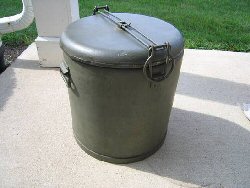
Handles:
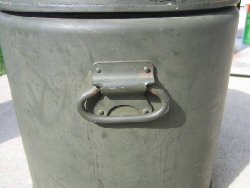
Closure:
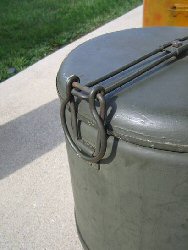
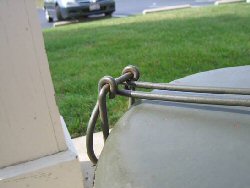
Top Detail:
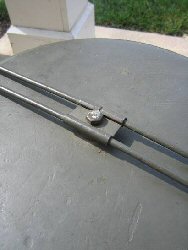
Bottom:
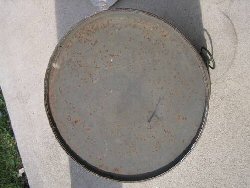
Inside of the lid and makers mark - note that both were made in 1944.
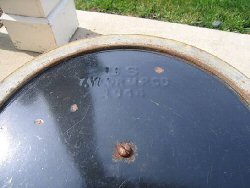
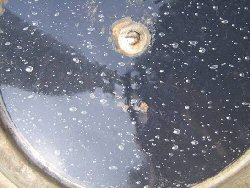
Lip and gasket detail:
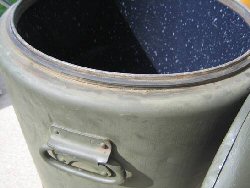
Inside:The interiors came in blue speckle enamel as well as tinned steel. There has been supposition that the blue enameled ones were for blood transport, but I have not found any primary source documents stating that they were for blood transport ONLY and the tinned steel lined ones were for food transport ONLY. In general, the blue speckled ones seem to be far more common than the tinned steel ones.
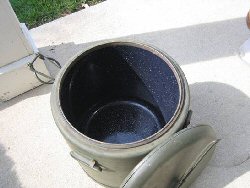
|
Inserts: There were two types of inserts, 4 Gallon, and 1.75 gallon. They were made in 3 different materials, Aluminum, Stainless Steel and Tinned Steel. The most commonly seen type is the Tinned Steel type, with Stainless and Aluminum being mixed evenly. The Tinned Steel types are predominantly dated 1942, 1943 and 1944. The Stainless Steel ones that I have seen were dated 1944. I have seen 1941, 1944 and 1945 dated Aluminum containers and lids.
Typical Range of condition tinned steel inserts, poor, OK, good
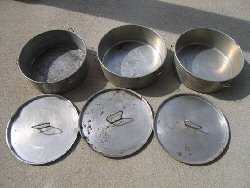
1941 Dated Aluminum Lifetime 1.75 Gallon Insert
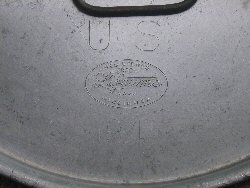
1942 Dated Tinned Steel LMR 1.75 Gallon Insert
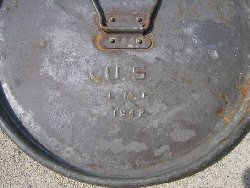
1943 Dated Tinned Steel SMCO 1.75 Gallon Insert
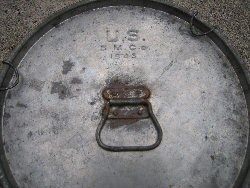
1944 Dated Stainless SMCO 1.75 Gallon insert
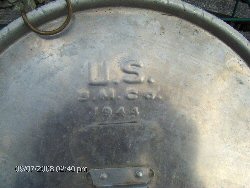
A 4 Gallon insert next to a 1.74 Gallon Insert
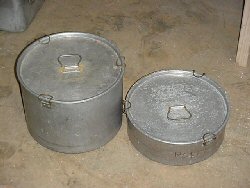
Photo Courtesy of Robin Bartel
Side View
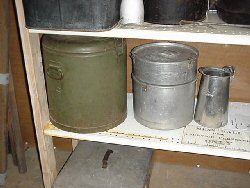
Photo Courtesy of Robin Bartel
|
Container, Insulated, M-1944:
So what is a Container, Insulated, M-1944?
Here's a scan from the May 18, 1945 Quartermaster Journal:

Image and archival support courtesy of Mr Dwayne Tooley, aka Quartermaster.
As you can see - it looks "JUST" like the postwar variety "haybox" "Mermite" coolers you see many reenactors and military vehicle enthusiasts using.
Here are 1952 and 1983 date examples:

Image Courtesy of Alfred DeVaux jr.
1953:
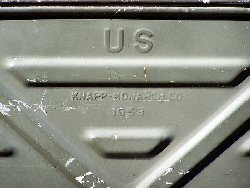
Image Courtesy of Alfred DeVaux jr.
1982:
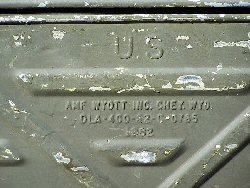
Image Courtesy of Alfred DeVaux jr.
Take note of the embossed pattern in the top:

Image Courtesy of Alfred DeVaux jr.
|
Observations:
1.) Note how that the container illustrated in the QM journal does not have the very large reinforcing X across the body? This must be the first pattern illustrated or very early production- and was later changed to reinforce the body - much like a 5 gallon gasoline can.
2.) Ok, so on closer inspection - but still within the 6 foot rule I can see the date embossed in the side of the can being 1982.
3.) The lid embossing pattern is rectangles perpendicular to the long sides - the example illustrated in the QM journal has no reinforcing stampings.
Ok, now let's really mix it up...
A 1945 Dated M1944 Mermite can -
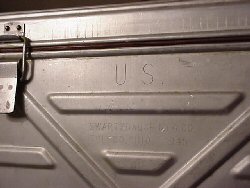
Image Courtesy of Robin Bartel
Side view - note the different lid pattern:
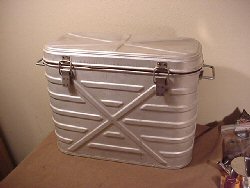
Image Courtesy of Robin Bartel
Observations:
1.a) Ok - so this de-bunks the X idea... a 1945 dated example has the X - so that makes the bodies of the coolers similar -
2.a) still have the wrong date on them - in embossed lettering rather than imprinted stamped lettering.
3) The lid pattern is totally different than the postwar versions, and has a reinforcing X on the top that the one illustrated in the QM Journal does not have.
Lets look at the most important detail: Historic Context - would troops in the ETO have seen it?
Some would argue that since it is labled "M-1944", it was designed and adopted by the end of 1944, and thus would have had enough time to been put into production and transported overseas to the troops. This fallacy falls in the same bucket as M3a1 Grease Guns in combat service in the ETO, Bayonet Lugs on Carbines in the ETO and ALL units FULLY MEETING their TO&E upon intduction to combat service in the ETO. We all know they're utterly false, but some still cling to the belief that if it was designed and possibly produced in some quantity during WW2 therefore it is righteous to use for display.
4.) Excerpt from Quartermaster Journal, dated May 18, 1945 (Yes Virginia, that is AFTER V-E DAY.)
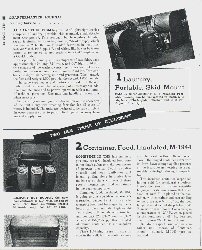
Image and archival support courtesy of Mr Dwayne Tooley, aka Quartermaster.
Strike 3. Even the Army came right out and said - DON'T expect to see these new "Container, Food, Insulated, M-1944" for a while - and that is even after V-E Day.
|
Where to get a "Container, Round, Insulated, M-1941"?:
Ebay, Flea Markets, the usual sources. Expect to pay between $5 and $300 depending on condition, completeness with inserts, how knowledgeable the seller is, and how bad you or somebody else wants it.
The inserts typically go from $5 to $30 on Ebay and at Flea Markets. Once again, subject to the above conditions.
There are no known reproductions of this item at this time. The author has been contacted by individuals wishing to make reproductions, but no progress has been made as of yet.
Got any buddies in China?
|
Conclusion:
I realize the number of M1941 Mermites is finite and are hard and often expensive to acquire. We dont all have the financial resources or luck to have all the best gear and equipment right now. Often we have to make compromises for our comfort or safety, and having a ready supply of drinks is certainly one of those things.
Should you own and use a M1944 Mermite, or one of the other non military insulated containers, use discretion and simply keep it out of sight during public display hours.
Simply knowing what is and what is not period correct can go a long way in improving the overall camp display and individual impressions.
|
Acknowledgements:
Special thanks to Mr Dwayne Tooley, Mr Robin Bartel and Mr Alfred DeVaux jr. for his help with this article. Mr Tooley's work and scans from the Quartermaster Museum collection allowed me to provide historical context through primary source documentation. Mr Bartel has once again been able to help me with research and photographs from his extensive collection. Finally, thanks to Mr DeVaux for the photos of the modern M1944 insulated containers. Their generosity and courtesy is most appreciated by the 90th Infantry Divison Preservation Group and the reenactor community at large.
|




























